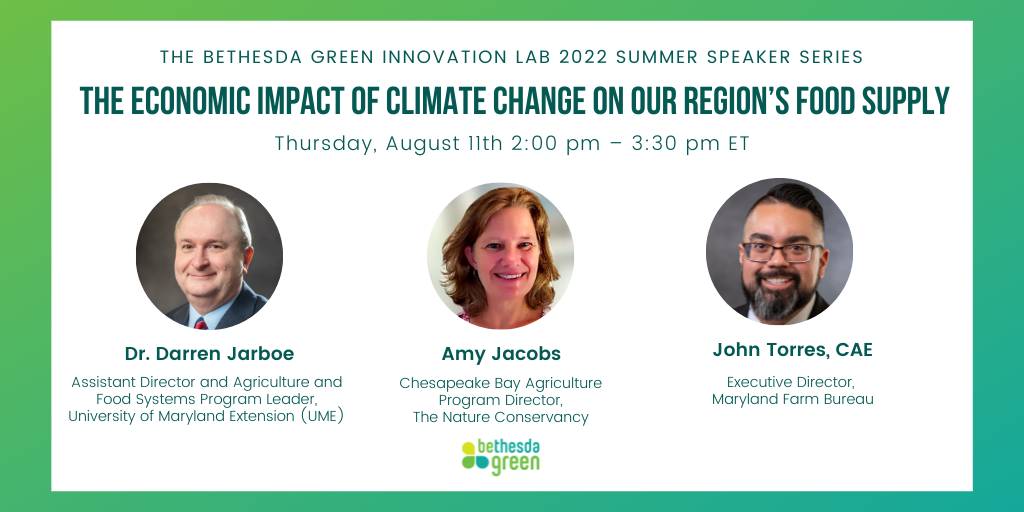2022 Summer Speaker Series: Tackling Environmental Challenges Through Sustainable Entrepreneurship
This summer, Bethesda Green’s Innovation Lab is once again bringing together founders, industry experts, and policy makers for a series of conversations that will inspire and educate all who attend.
During our 2022 Summer Speaker Series, 12 industry experts are coming together to discuss the impact of required climate related financial disclosures, and some of the key challenges and opportunities facing our food system.
The following is a summary of the session hosted on Thursday, August 11th. Watch the recording here: https://youtu.be/OCgz9doMAv4
Session #2: The Economic Impact of Climate Change on our Region’s Food Supply
Panelists
- Dr. Darren H. Jarboe: Assistant Director and Agriculture and Food Systems Program Leader, University of Maryland Agricultural Extension Program
- Amy Jacobs: Chesapeake Bay Agriculture Program Director, The Nature Conservancy
- John Torres, CAE: Executive Director, Maryland Farm Bureau
During this session, we brought together three expert panelists to discuss the economic impact that climate change is having on our region’s food supply. Amy Jacobs is the Chesapeake Bay Agriculture Program Director at the Nature Conservancy. Dr. Darren Jarboe, is the Assistant Director of Agriculture and Food Systems Program Leader at the University of Maryland Agricultural Extension Program. John Torres is the Executive Director and Chief Executive Officer of the Maryland Farm Bureau. Below, please find a collection of some of the key takeaways from this session.
Agriculture in Maryland and the Chesapeake region is extremely diverse. According to NOAA, The Chesapeake Bay is the nation’s largest estuary. Its 64,000 square mile watershed encompasses one of the most economically significant regions of the United States, and is home to more than 18 million people. The Chesapeake produces about 500 million pounds of seafood each year, supporting jobs in both commercial and recreational fishing and bolstering the regional economy. In addition to food crops, agriculture in this region includes dairy and livestock, poultry, honey, horticulture, and vineyards.
As our region responds to the constantly changing environmental pressures caused by climate change and political-socio-economic pressures, scientists, farmers, and some policy makers are increasingly sounding the alarm about the need to protect our food supply. Yet while the likely disastrous impact of climate change on our food supply is worrisome, some also see an opportunity for innovation and economic growth.
Impacts of Climate Change on the Food System
Some of the major impacts of climate change on our region’s agriculture industry, according to Darren Jarboe, Assistant Director and Agriculture and Food Systems Program Leader at the University of Maryland Agricultural Extension Program, get directly to the heart of a farmer’s ability to earn revenue. These include the loss of land due to saltwater intrusion, higher nighttime temperatures that affect the crop yield, rainfall events that will increase salinity in the Chesapeake Bay and thereby change the seafood populations, and changes in irrigation techniques as periods of extreme heat lengthen. Moreover, urban development limits the amount of available farmland, reducing our ability to create food, and thereby increasing the cost of living in the area. Development in turn affects stormwater management, as more impervious surfaces drive more pollution into the Chesapeake Bay.
Amy Jacobs, the Chesapeake Bay Agriculture Program Director at the Nature Conservancy, added increased yield variability, caused by extended seasons impacted by drought and flooding, and rapidly rising drought-influenced insurance payments as additional challenges facing farmers today. Insurance payments to farmers as a result of droughts have risen more than 400% from 1995 until 2022.
Farmers also face operational challenges such as labor intensity, high input costs combined with thin margins, and regulations that exclude smaller sized farms. John Torres, the Executive Director of the Maryland Farm Bureau, noted that while these challenges will often impact businesses in many industries, small farmers are hit particularly hard. Small teams often lack the in-house knowledge and staff, such as lawyers and accountants, that help them remain compliant in the face of complicated regulations.
From Idea to Implementation
Stakeholders in the agricultural industry are constantly looking to identify ways to tackle some of the biggest challenges facing the variety of farmers today, which makes this an exciting space for entrepreneurs and researchers. For instance, Jarboe and his research teams at UMD’s Agricultural Extension Program conduct applied research techniques to demonstrate and test new innovations, sourced from both the private and public sector, with farmers in the field. Efforts to work closely with farmers to demonstrate the risks and rewards of new innovations can often help to mitigate their concerns.
In addition to Maryland’s Agricultural Extension Program, farmers are increasingly exploring ways to take advantage of Maryland’s Department of Agriculture Cover Crop Program, which encourages farmers to grow suggested species of cereal grains and legumes during the off season. This allows for reduced erosion and run-off during the winter months and has benefits for the soil health. As farmers test out these new strategies, they’re learning through the process what works and what does not.
The 4R Nutrient Certification Program, co-founded by The Nature Conservancy, was designed to solve water quality issues and alleviate the cost to the farmer. The 4Rs refers to using the Right Source of Nutrients at the Right Rate and Right Time in the Right Place. The program includes an extensive list of best management practices (BMPs), a few of which Jacobs talked about in detail, including improving soil health through precision nutrient application and crop management. Crop management practices include diversifying the crops that are planted, promoting crop rotations, and decreasing the amount of soil turnover, which can lead to reduced nutrients in the soil. By directly applying nutrients, rather than widespread spraying, farmers can save on costs and reduce the amount of nitrogen spread in the area. Jacobs pointed out that since 1985 farmers have reduced nutrient pollution in the Chesapeake Bay, with nitrogen reducing by 25% and phosphorus reducing by 45%.
Priorities for innovation will focus on ways to reduce the amount of resources used in our agricultural system and drive down energy costs. To do so, we need to ensure support for the entrepreneurs and researchers within this field.
Available Funding
Torres reminded listeners that farmers operate on razor thin margins. When farmers work to adopt new technologies or practices, they must weigh the risks of failure against their need to earn a living. Funding opportunities, especially from the federal government, can reassure farmers that they can afford to risk some change. He described how the United States government started the conservation management movement during the Dust Bowl era by investing in solutions to the environmental and ecological changes happening at the time. From there, the US created the Land Grant system, where universities were encouraged to move research directly into the field, and that continues today through cooperative extension programs. However, there have been budget cuts over time that do not correspond with the need for more qualified scientists doing important conservation research.
Currently, there are both state and federal avenues for funding for our farmers. At the federal level, farmers receive major support from the Farm Bill, which includes a variety of safety net, farm loan, conservation, and disaster assistance programs. The United States Department of Agriculture also provides support to farmers through the Natural Resources Conservation Service and their variety of financial assistance programs. Among them, the Environmental Quality Incentives Program (EQIP), can help farmers fund conservation efforts that strengthen the resiliency of their own operations. Jacobs reminded us that at the state level, Maryland was one of the states that made early investments into cost share programs and incentives for farmers to commit to Best Management Practices.
Concluding Takeaways
In closing, we asked our panelists to share one message that they wished the audience knew about the intersections of climate change, economics, and food supply. Torres began by stating that Maryland farmers are willing and helpful partners in solving environmental challenges. Consumers should strive to get to know their local farmers and learn more about the specific issues they face. He emphasized that the farming community has done a lot of work to reduce their footprint over the years, yet they recognize there’s more work to be done.
Jacobs echoed Torres’ sentiment and shared that agriculture is the largest land use in the Chesapeake Bay region and we want to keep it that way. The only path to restoration of the Chesapeake Bay requires farmers, so they need to be met in the field with sustainable practices that work for the environment and their livelihood.
Finally, Darren Jarboe concluded with a call to action for audience members to strengthen their own understanding of the food system and promote agricultural literacy in our communities.
Find your local farmers and support here:





